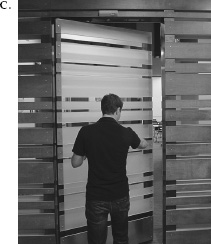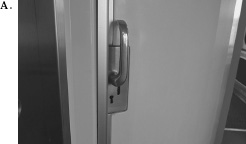Read The Design of Everyday Things Online
Authors: Don Norman
The Design of Everyday Things (5 page)
Not only did my explanation fail to satisfy the design community, but I myself was unhappy. Eventually I gave up: designers needed a word to describe what they were doing, so they chose
affordance
. What alternative did they have? I decided to provide a better answer:
signifiers
. Affordances determine what actions are possible. Signifiers communicate where the action should take place. We need both.
People need some way of understanding the product or service they wish to use, some sign of what it is for, what is happening, and what the alternative actions are. People search for clues, for any sign that might help them cope and understand. It is the sign that is important, anything that might signify meaningful information. Designers need to provide these clues. What people need, and what designers must provide, are signifiers. Good design requires, among other things, good communication of the purpose, structure, and operation of the device to the people who use it. That is the role of the signifier.
The term
signifier
has had a long and illustrious career in the exotic field of semiotics, the study of signs and symbols. But just as I appropriated
affordance
to use in design in a manner somewhat different than its inventor had intended, I use
signifier
in a somewhat different way than it is used in semiotics. For me, the term
signifier
refers to any mark or sound, any perceivable indicator that communicates appropriate behavior to a person.
Signifiers can be deliberate and intentional, such as the sign
PUSH
on a door, but they may also be accidental and unintentional, such as our use of the visible trail made by previous people walking through a field or over a snow-covered terrain to determine the best path. Or how we might use the presence or absence of people waiting at a train station to determine whether we have missed the train. (I explain these ideas in more detail in my book
Living with Complexity
.)



FIGURE 1.2.
  Â
Problem Doors: Signifiers Are Needed.
Door hardware can signal whether to push or pull without signs, but the hardware of the two doors in the upper photo, A, are identical even though one should be pushed, the other pulled. The flat, ribbed horizontal bar has the obvious perceived affordance of pushing, but as the signs indicate, the door on the left is to be pulled, the one on the right is to be pushed. In the bottom pair of photos, B and C, there are no visible signifiers or affordances. How does one know which side to push? Trial and error. When external signifiersâsignsâ have to be added to something as simple as a door, it indicates bad design. (Photographs by the author.)
The signifier is an important communication device to the recipient, whether or not communication was intended. It doesn't matter whether the useful signal was deliberately placed or whether it is incidental: there is no necessary distinction. Why should it matter whether a flag was placed as a deliberate clue to wind direction (as is done at airports or on the masts of sailboats) or was there as an
advertisement or symbol of pride in one's country (as is done on public buildings). Once I interpret a flag's motion to indicate wind direction, it does not matter why it was placed there.
Consider a bookmark, a deliberately placed signifier of one's place in reading a book. But the physical nature of books also makes a bookmark an accidental signifier, for its placement also indicates how much of the book remains. Most readers have learned to use this accidental signifier to aid in their enjoyment of the reading. With few pages left, we know the end is near. And if the reading is torturous, as in a school assignment, one can always console oneself by knowing there are “only a few more pages to get through.” Electronic book readers do not have the physical structure of paper books, so unless the software designer deliberately provides a clue, they do not convey any signal about the amount of text remaining.



FIGURE 1.3.
  Â
Sliding Doors: Seldom Done Well.
Sliding doors are seldom signified properly. The top two photographs show the sliding door to the toilet on an Amtrak train in the United States. The handle clearly signifies “pull,” but in fact, it needs to be rotated and the door slid to the right. The owner of the store in Shanghai, China, Photo C, solved the problem with a sign. “
DON
'
T PUSH
!” it says, in both English and Chinese. Amtrak's toilet door could have used a similar kind of sign. (Photographs by the author.)
Whatever their nature, planned or accidental, signifiers provide valuable clues as to the nature of the world and of social activities. For us to function in this social, technological world, we need to develop internal models of what things mean, of how they operate. We seek all the clues we can find to help in this enterprise, and in this way, we are detectives, searching for whatever guidance we might find. If we are fortunate, thoughtful designers provide the clues for us. Otherwise, we must use our own creativity and imagination.



